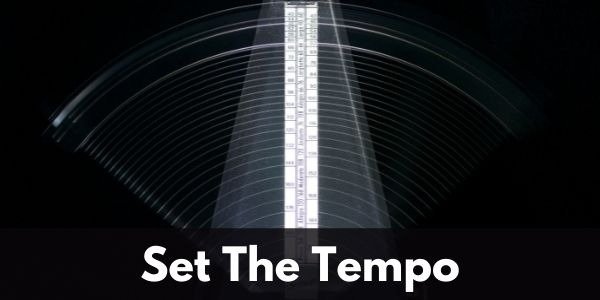It’s time to make some beats for y’all.
Whether you want to liven up the party or just get your name out there, you’re going to need some good beats to accomplish that.
That’s why in this guide we are going to show you how to make beats so that you can get started in your music production career whether it’s for fun or you are an aspiring professional.
So let’s get started.
1. How To Make A Good Beat: The Fundamentals
Before you make any beats, I highly recommend that you have some foundation in music theory.
If you are coming with no musical knowledge, it is going to be difficult to find chords and notes that go well together.
It’s like trying to write the word “apple” without knowing the English alphabet. You can definitely copy it but you won’t know the reason why apple is spelled that way and wouldn’t know how to write the word “cat” without again copying (while still having no clue how the word “cat” was formed…)
So back to music theory…
Sure, it’s possible to play notes randomly and find something you like…
But just having a little foundation to give you that direction will make it easier and faster to find a melody that you enjoy.
For example, if you had no music theory, you wouldn’t know that in the Major C scale (the scale with only white notes) that the black keys will sound off.
But if you knew just the basics of music theory, you know that those black keys can help you make some sick sounding minor chords, add some dissonance to your music, or know which chord progressions will go well with the song you’re thinking in your head.
So is it mandatory?
Nope.
But will it make your life easier?
Absolutely.
So I recommend you learn just a little of music theory. Just a teensy bit with the formation of chords and basic scales.
2. Choose Your DAW

Okay, if you’re completely brand new, then your question is probably…
“What the hell is a DAW?”
And I don’t blame you because that’s what I asked when I kept seeing this word.
To put it into some context, GarageBand and Logic Pro X are DAWs.
It’s a Digital Audio Workstation so you can make music and beats.
Think of it as Adobe Premiere for video editors or Photoshop for graphic designers.
It’s a tool for “audio editors.”
So now you know what it is, your next question is probably…
“Which DAW should I choose?”
And I highly recommend something easy and free like GarageBand (if you have a mac) to get your toes wet.
The reason for this is that you just want to execute on creating beats.
It truly doesn’t matter what DAW you choose in the beginning, but you should focus on one where it’s user friendly so you can learn less about the software and spend more time on making your first beats.
And then when you learn beats, you can figure out what you like and don’t want in your DAW and have more research to choose which DAW to use in the future.
Back to the video editing reference, it’s like editing on something like iMovie to figure out if:
- You actually enjoy it
- The little things that you like or don’t like about the current software.
But here are some solid choices to choose for your DAW:
- FL Studio
- Logic Pro X
- Garageband
- Ableton Live
You can’t really go wrong with any of these when starting out.
To put it in perspective, I went from GarageBand to Logic Pro X once my skills got better at making bets.
So just pick one and let’s start making some beats!
3. Choose Your Genre
Now, before you choose your software, get your equipment, etc. I again recommend you choose a genre to specialize in.
Basically…
What type of music should you create?
There’s so much genre and each one has it’s own little specialties from:
- Hip hop
- Electronic
- Pop
- Trap
- Etc.
And each one differs completely from the rest.
The reason why you want to specialize from the get go is so that you can see genuine improvements over time.
Each genre has a lot of little things and when you’re bouncing from genre to genre, you become a “jack of all trades” rather than a master at one genre.
So why is this important for a beginner?
Because when you’re a beginner, chances are you want to improve as fast as possible (cause that was me…)
And when you focus on one thing, you will improve at that one thing exponentially faster than if you focused on multiple things.
Which makes sense.
Think of it like this. If you want to learn to play music, you can choose a ton of instruments like the guitar, piano, saxophone, violin, etc.
If you spend 10 hours learning each instrument, you will probably be able to use each instrument…
Versus just picking one instrument and putting 40 hours into it.
In other words, if you focus on just one thing you will improve drastically faster than bouncing everywhere.
It also applies to life… (kinda…)
Anyway, if you don’t know what to specialize in, think of the music you enjoy and experiment in the beginning to see what you like before you specialize in.
But the faster you specialize, the faster you will improve.
4. Set the tempo

One of the first things you want to do when creating beats is you want to set the tempo of the song.
The question is…
Do you want a fast song or a slow song?
Most of this is pretty intuitive if you have listened to songs, but usually you pick a slow song if it’s a sad or emotional song or a fast song if you want to make it energetic or upbeat.
So how do you choose what BPM should be?
The best part is to pick one that sounds what you’re thinking of and adjust along the way.
The best part with DAWs is that when you change the BPM, you can hear how it sounds when it’s slowed or sped up, allowing you to choose what best suits what music you’re going for.
5. Choose The Melody For Your Song
Once you have decided on a song to use, then the next step is to choose the melody for your song.
This should be the bread and butter of your entire song.
This can be a simple four chord progression where you go crazy with all the harmonics and synths…
Or it can be as simple as a simple 3 note sequence.
It truly depends what you’re trying to go for when you are creating your music.
There’s three major ways on how to create a melody for your song:
- Play randomly and see what sounds good and go from there (A legit good start to making music…)
- Listen to famous songs that you enjoy and draw inspiration from their chord progressions…
- Take a shower and wait for inspiration to hit randomly…
Okay, you don’t have to take a shower, but that’s where a lot of my good beats come from.
Another thing you want to consider with your melody is where you’re going with the entire song.
What’s the story of the song and is the melody in sync with that music?
For example, if you have an amazing upbeat melodic song but you have lyrics for a slow, emotional heartbreak song…
It’s probably not going to mesh well.
And that’s not the only thing to consider what genre the song is, but does the melody emphasize the parts you want to emphasize in your lyrics and helps express what you’re trying to say in your music.
In the end, you should focus your melody on trying to express your song at its core.
So choose your melody, but through iteration is where your melody gets better as the more rough drafts you go through.
6. Structure Your Song Correctly

Another thing you want to consider is to structure your song correctly once you have your DAW, melody, and the type of song you want to create.
What a lot of amateurs (and even professionals) struggle with is that once they figure out a beat, they realize that they have this amazing chorus and spend hours upon hours on making it perfect…
And then they realize they don’t know what to put in the beginning and ending.
You want to have a general idea of the structure of your song so that you don’t run into this problem.
You want to consider 3 three things:
- What are you trying to convey to your listeners?
- What do you want it to sound like?
- How do you want the beginning, middle, and the end to sound like?
That’s it.
Once you can figure this out, you have a great basis on how to make your music.
Think about it like this.
Let’s say we are happy kids screaming for ice cream type of music…
So a happy and energetic song.
And what we’re trying to convey is that life is amazing.
Now in my head, I’m imagining happy chord progressions with a loud bang in the chorus.
So now I have a general idea of how my song is.
Now let’s get a bit more specific.
The question I’m missing is…
“How do I want to start my music and how do I want to end it?”
So then I want to start it as a slow ramp up and end it with a slow ramp down.
And then we get more specific.
I want a verse-chorus-verse-chorus-bridge structure.
And then we get more specific.
I want to add goat noises somewhere.
You see what I’m doing here?
I’m getting a general overview of the song and slowing drilling in the elements of what I want.
Then I start with that general framework and then start experimenting to see what I like and don’t like about it, but I have direction and structure on what I am ultimately trying to accomplish.
This isn’t the “only” way to make music, but it’s an effective starting point when you’re starting out to make beats for beginners.
7. Have A Unique Selling Point
This is more for when you get the hang of making beats, but when you’re making beats, you want to consider having a unique selling point.
Over 24,000 songs are made every single day, putting you at a disadvantage when trying to get your music listened to.
And if you want your music to get noticed, then the question you should ask yourself is…
“Why should listeners want to listen to me?”
- Do you make them feel a certain emotion?
- Are your lyrics relatable to them?
- Do they like your character?
- Is there a distinct sound in your music that they love?
It’s answering these questions that allow you to get closer to making music that wants to get listened to.
And there are some ways to make your beats unique so that people will listen like:
- Having certain vocal chops mixed in
- Certain rhythms and beats
- A unique intro/outro to your songs
But what you’re looking for is that certain “sound.”
For example, Droeloe does a good job at this where, although each music is different, it has that same “element” that you know it’s created by Droeloe (or you can hint at it…)
And how do you do that?
Practice and experimentation.
This is a lifelong journey that you can take if you want, but there is no textbook step-by-step example…
It’s getting better at your craft and maximizing your chances of success.
But don’t worry about that in the beginning and just have fun making beats in the beginning…
I’m just planting ideas in your head for when you progress in your beat-making journey.
8. Experiment With Sounds

You can do many crazy things with the sounds you can make.
It basically comes down to…
“How big is your imagination?”
You can make some deep, emotional voice really pack a punch and make you cry a river…
To making goat noises sound awesome in a trap remix. (Are you up for that challenge?)
Go crazy and try experimenting with sounds.
Here are some ideas to consider that will help get your imagination juices running:
- Create vocal sounds and try changing the pitch and intensity…
- Start adding multiple of the same instruments (like drums) and see if you can make a sick beat…
- Start adding everyday noises like shower noises and see if you can add elements to make your existing songs better…
- Find some troll noises (like a horse neighing) and try to make it sound good by editing the EQ and even making drops to it…
- Start breaking rules and have no repetitions in your music or a song using just the xylophone…
These ideas are random, but that’s the point.
It’s trying things outside of what you’re used to, where more ideas will grow.
And remember to have fun. If you’re not enjoying making horse neighs sound good, but you really enjoy the noises turtles make when they walk across the sidewalk…
Then go for that.
In the end, these are all ideas to help you get started to becoming the musician you want to be.
Frequently Asked Questions
Is it hard to make beats?
It depends. It can be as simple or as difficult as you’d like it to be. You can make a simple 4 chord progression on the piano or you can make trap music. It all depends on what you feel like making and how difficult you’d want it to be.
What materials do you need to make beats?
The materials you need to make beats are a DAW and a laptop. Then after that, I highly recommend getting headphones and a nice mic to record.
What artists use FL Studio?
Famous artists who use FL studio include:
- Avicii
- Deadmau5
- Porter Robinson
- Alan Walker
- Soulja Boy
And many others. But, you can probably find other famous artists who use different DAWs.
It’s not the equipment, but the skills that make the difference. But having a powerful DAW to support your skills is always a nice thing to have.
Conclusion
I hope you learn something about where to start when making beats for beginners. It can be daunting when you’re starting out, especially when you have no music theory knowledge, but remember…
It’s possible if you truly want to learn it.
With the vast amount of resources like YouTube and Google, it’s practically impossible not to learn it if you truly desire it. Let me know in the comments if you took a leap and created your first song!
